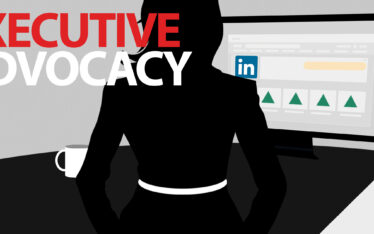
We could talk about the benefits of a positive reputation all day. We could spout statistics on brand trust and loyalty. But let’s be honest: as a business owner, your number one concern is revenue. We hear you. So, we’ll stick to the bottom line: Your company’s reputation has a direct impact on its revenue. Consider that:
- More than 25% of a company’s market value is directly attributable to its reputation. [source]
- A difference of one star in the average rating in a typical online business profile can lead to a 5–9% difference in revenues. [source]
- More than 8 in 10 people will pay more for services from a company that has higher ratings and reviews. [source]
Clearly, it’s in your company’s best interest to dedicate resources to ensuring a strong brand reputation. So, let’s talk about how to make consumers (and buyers) fall in love with your brand!
#1 Be present
Your brand has countless opportunities to create “mini moments” through exceptional customer experiences, but these can only take place if you’re present at every possible touchpoint along a customer’s path to purchase. Brands need to be ready and waiting where their customers are so they can provide assistance, answer questions, offer insights, and yes, sell products and services, when and where a customer is ready. With the right tools, you can make this process oh-so-much easier. In addition to having a customer service line and/or a brick and mortar location where you can meet customers face-to-face, your brand should also be ready to engage via:
- Website
- Create content that answers their questions and helps them make smarter, more informed decisions.
- Update your FAQ page as new products/services are added or questions evolve.
- Use chatbots to provide immediate answers to customers’ most common questions and concerns and to free up team members’ time for complex requests.
- Social Media
- Share content – both original and curated from third-party sources – that’s relevant to your audience.
- Create highly-targeted ads that help net-new customers find you when they’re ready.
- Respond quickly and professionally to questions, comments, complaints and reviews.
- Search
- A robust Google My Business page helps potential customers find your business and gather necessary information, such as hours, directions and offers.
- Turn on the free “messaging” option within GMB to respond directly to consumers who reach your page and have a question or concern.
#2 Kill the crickets
You send a text to someone after a first date, and …. crickets. Three days later you send a few question marks, wondering if they just forget to respond or if they just chose not to. Yeah, it’s not cool to leave someone hanging. Same goes for your brand. Don’t leave your customers with crickets.
Pop quiz: Which of the following scenarios requires an immediate response:
- A Facebook follower comments on one of your social posts.
- A disappointed customer leaves a 2-star review on Google.
- A Twitter follower tags your brand in a post asking when a new product will be available.
- A new customer leaves a glowing 5-star review.
Hopefully you answered, “all of the above!” Yep, in every one of these scenarios, a quick response from your brand is required. If you don’t deliver, you’re effectively ending the conversation. What you do online should be no different than how you’d act in person. If a customer approached you in your store to tell you they had a terrible experience, would you walk away? If you’re a smart business owner, you’d apologize and ask them to tell you more about it so you can remedy the situation. That’s what your customers are looking for from you online. And remember, others are watching to see not only if you respond, but how. In fact, nine in 10 people look at poor reviews to see how the company handles negative feedback before engaging with that business.
The closer you are to your brand, the more difficult it can be to formulate an appropriate response. The brands we work with were managing this on their own prior to working with us, and every one of them has admitted to responding emotionally, too quickly, or unprofessionally in at least one instance. That’s not because they aren’t professionals. That’s simply because their brand is their baby. You’re already in love with your brand, so when someone leaves a negative review, your gut reaction is to defend your baby. This is precisely why it’s a good idea to have someone else handle this task – someone you trust, who can read and respond objectively.
#3 Listen
Monitoring and social listening help you better understand what’s most important to your audience – their challenges and questions, their favorite brands, etc. If you aren’t actively listening via social media channels and digital tools, you’re missing out on conversations around your industry and your brand. Without listening, you don’t know who your most loyal brand advocates are, what your competitors are doing, what your customers are saying about you, or what consumers really think about your products and services. If you’re doing all the talking and none of the listening (there’s one at every party, right?), you’re bound to get dumped eventually.
On the other hand, if you do practice active listening, you just might find opportunities to create meaningful relationships.
True Story: a loyal hotel customer was late to book a room for an upcoming conference. He mentioned the brand in a Twitter post about the lack of rooms in the city. The brand saw his tweet and recognized him as a loyal customer of their chain. Without a single room left to offer, the hotel manager found him a room at a competitor hotel down the road and get this: booked it for him – courtesy of their hotel! Yes, they sent him to a competitor, but which hotel do you think he remembered for future bookings? If they hadn’t been listening on Twitter, they’d have missed that opportunity all together. And that means missing out on all the engagements and impressions that tweet earned, not to mention the loyalty of the customer, and the lasting impression the brand’s response made on thousands of followers.
#4 Understand them
If you paid attention to number three, and really are listening to your audience, you’ll begin to understand them, which is fundamental to any relationship. How much stronger is a relationship between two people when both parties know the other; not just their likes and dislikes, but their biggest fears, greatest challenges, deepest regrets and highest aspirations. There’s psychology to back this up. Feeling understood makes us feel like we belong, that we matter. It also helps us feel more deeply connected to each other, improving the quality of our relationships.
Equally important to understanding your customer is showing them that you understand or at the very least, want to understand them. Here’s a pro tip for responding to a poor review or a complaint: repeat back to them their concern or issue, let them know you hear them and that you understand them, then work to find a solution that shows them you understand. When you understand your customers, you can respond to them in a way that meets their needs and helps them remember you. When your brand communicates clearly, you’re able to show your audience what you’re about, make them feel an emotion, and drive them to act. Regardless of how you respond, you’re likely to draw an emotion from them – make sure it’s a positive one!
#5 Tap into their emotions
You’ve likely heard the Maya Angelou quote: “…people will forget what you said, people will forget what you did, but people will never forget how you made them feel.” The same can be said about brands. In fact, the single greatest influence on a consumer’s intent to purchase is their emotional response. Making customers feel heard and understood, meeting their needs, and going out of your way to deliver an exceptional customer experience, triggers emotions – joy, compassion, happiness, satisfaction, pride, surprise, empathy – they’ll associate with your brand.
The goal of every marketing campaign is to make audiences feel more deeply connected to your brand. Every interaction your customer has with your brand – online and off – has the potential to do this:
- Serving up an ad with the right message, at the right time
- Writing a thoughtful reply to an online review
- Responding quickly to resolve a compliant on Twitter.
Clearly communicating your brand’s message in a way that resonates with your audience leaves a lasting impression. Don’t underestimate the power of an emotional response. It can lead to higher spend, greater profit, and a stronger bottom line for your brand.
These five tactics can help you create moments that make your audience fall in love with your brand for the first time, or again and again. It’s these deep connections that make your brand irresistible.
Does your brand have a reputation management strategy in place that can help you create these moments and drive business growth? Drop us a line and we’ll set up a time to chat.


